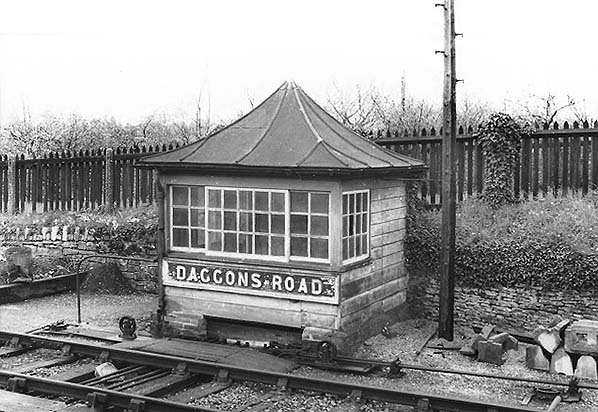
Station Name: DAGGONS ROAD
Daggons Road Station Gallery 1: c1908 - c1930s
road_old1pg.jpg)
Circa 1908 (date of postmark) an Up passenger train approaches Daggons Road. The locomotive is a L&SWR Adams 4-4-0 and possibly a member of the 460 Class. Point rodding and the accoutrements of signal wire runs can be seen but it is unclear if the station was still fully signalled at this time, changes being introduced in 1903/4. The station buildings were something of a clutter. The two-storey station house can be seen, to which abutted two single storey structures. One is the booking office, visible here, while the other is largely out of view but indicated by its chimney stack. It was probably a goods or parcels office. Note the running-in board fixed to the roof of the booking office; a clearer view is offered in another photograph.
Photo from John Alsop collection 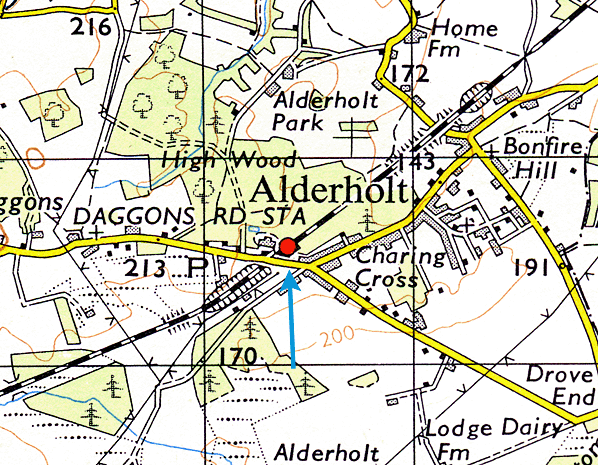
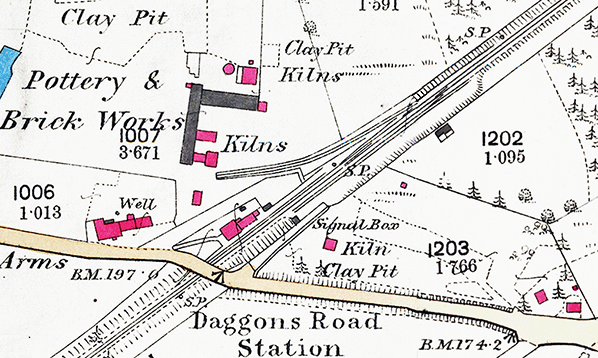 1889 1:2,500 OS map show the layout of the station with two sidings. One ran diagonally across the yard to serve the pottery and brickworks of Eustace and Colly and the other ran parallel with the pain line opposite the platform, this would have been for coal. This siding later became a loop. The signal box is at ther outh end of this siding. There is road access to the sidings on both sides of the line.
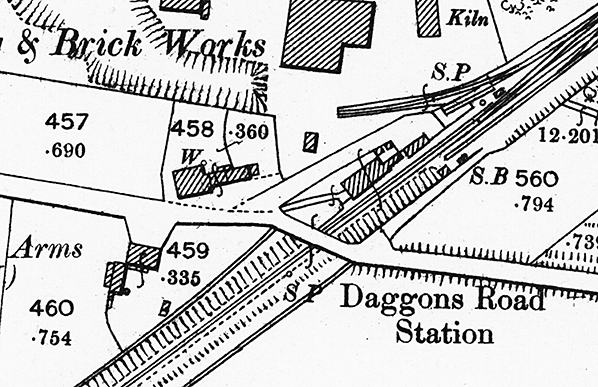 1901 1:2,500 OS map . A short siding has been added of the brickworks siding, this runs into asmall dock behind the platform.
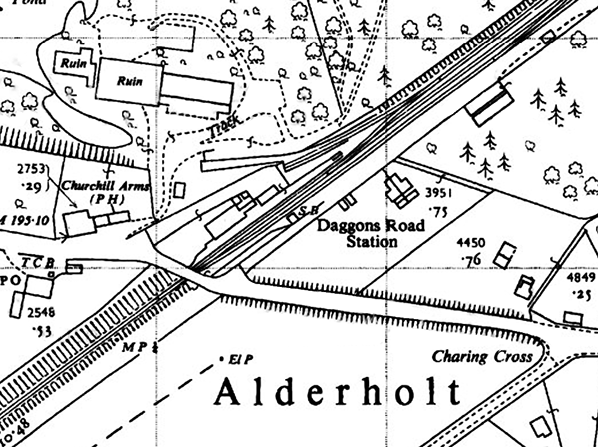 1959 1:2,500 OS map . The siding on the south sid eof the line has now been converted into a loop. On the north side of the line following the closure of the brickworks the private siding has been lifted leaving the short siding servig the dock.
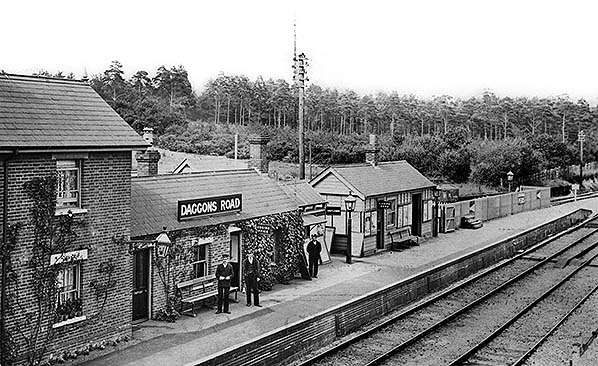 A rather delightful view of Daggons Road station, showing the aloof running-in board, before July 1906 (date of postmark). The spelling of the station was changed from 'Daggens' to 'Daggons' in 1904 as shown on the nearest platform bench. A number of noticeboards can be seen leaning against the platform buildings. As there is no room to mount additional boards and they already bear posters it must be assumed the loose boards were publicising some form of special event, excursions perhaps. The booking office is brick built and co-joined the station house. There was a second such structure behind the booking office, also co-joining the house and its chimney is visible to the immediate right of the house. This was probably a goods office. A third, smaller, building is visible in the background but its purpose is unclear. Of the two post-mounted platform lamps, that nearest the camera is mounted on what was probably a wooden post while that further along has a cast iron post. The third lamp, on the dock behind the fence, would appear to also have a wooden post. In later years all these lamps would find themselves mounted upon old sections of rail. Just beyond the end of the platform and to the left the points which led to the dock behind the platform and to the brick and pottery works can be seen, the latter located well out of view to the left. On the brick and pottery siding stands a LSWR open wagon. It has round-top ends but does not appear to be a tarpaulin wagon. Click here for a larger version of this picture with a more detailed caption.
Copyright photo from John Alsop collection road_old3.jpg)
Typically, photographs of Daggons Road station were taken from the bridge over the line as in this instance. The date is before July 1906 (date of postmark). The bridge marked the point at which Station Road became Daggons Road. Until the coming of the railway Station Road was named Alderholt Street. Alderholt village is to the immediate right. A Down train is approaching, hauled by what appears to be a L&SWR Adams A12 Class 0-4-2 known as 'Jubilees' due to being introduced in Queen Victoria's Golden Jubilee year. The headcode disc positions indicate Salisbury - Bournemouth West via Wimborne but also trains using all or part of this route as part of a longer journey. Thus the disc system inherited by the Southern Railway indicated route rather than type of train. There were six disc positions, that seen here being positions 2 and 3. Later this route was altered to positions 1 and 2. The purpose of the white gate at right centre background is unclear but it probably provided access to the siding for coal merchants. The siding on the right had been converted into a loop in 1904. The basic facilities for coal traffic can be seen adjacent to the wagons. Daggons Road signal box is partially visible on the right. By this time it been reduced to ground frame status and signalling, apart from shunt signals, removed. The signal box, a hut-like structure, was not untypical of this line but had an unusual pagoda-style roof which is unfortunately obscured from view by the tree. On the left we have a good view of the running-in board mounted on the roof of the booking office. This was later mounted on the platform by means of concrete stanchions but otherwise the station remained more or less in the condition seen here, albeit increasing decrepit, until closure. To the left of the locomotive can be seen the siding leading to the dock, with a van present, behind the platform while another siding, out of view, led off it to serve the nearby brick and pottery works.
Photo from John Alsop collection 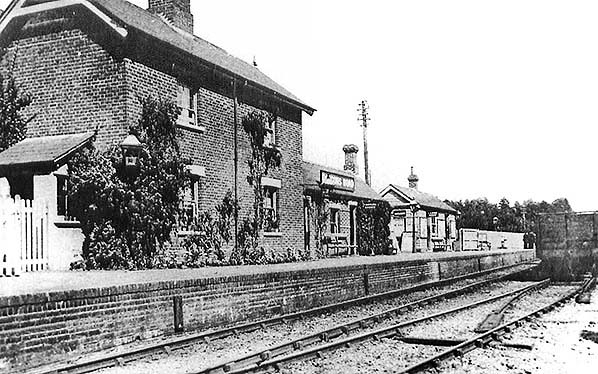 A relatively early view of Daggons Road, facing towards Fordingbridge, showing the roof-mounted running-in board and original lamp standards. Also clear to see is ballast covering the sleepers, this practice was outlawed sometime around the 1916 - 1920 period. The loop siding, right, is busy with coal traffic and the nearest wagon is uncomfortably close to the trap points which are set in the 'derail' position. At the end of each rail is a board of some form, presumably to aid rerailing should
a mishap occur. Photo from John Mann collection 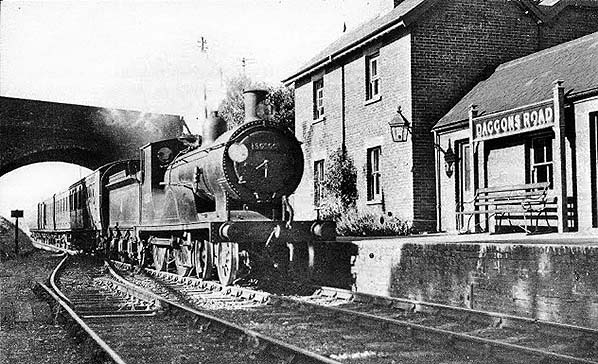 Ex-LSWR Drummond class T9 4-4-0 BR No.30300 brings its, probably ex-Bournemouth West, train into Daggons Road. The sunlight and shadows suggest the time was shortly after dawn. The train appears to be a 3-set formed of ex-LSWR vehicles; this and the presence of the early BTC logo on the locomotive's tender suggests the photograph dates from the early years of British Railways. The T9 class were good running and free steaming machines, with their rapid, for the time, acceleration earning them the nickname 'Greyhounds' along with their apparent ability to reach a speed of 85MPH. Built at Nine Elms in 1900 as LSWR No.300, this locomotive was to remain in service until March 1961 and was scrapped the following month. Of the once 66-strong class one, BR No.30120, has survived into preservation.
Photo from James Lake collection 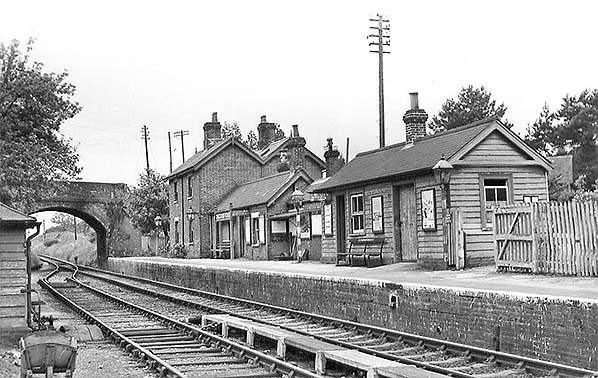 An unidentified stopping service pauses to pick uu passengers on a summer day circa early 1950s.
Photo from John Mann collection road_old2.jpg) Daggons Road in July 1957, looking much the same as it always did. Apart from the running-in board, once mounted on the booking office roof, one minor change is the post-mounted platform lamps. Originally mounted on purpose-made posts they are now mounted on lengths of old rail which have been painted in alternate black and white sections. This was a wartime embellishment to make so-painted items more visible during the blackout. Visible, just, in other photographs it is nonetheless much clearer here. It was common to also apply black and white marking to platform edges but there is no evidence of this being done at Daggons Road. The post-mounted lamp nearest the camera additionally has some form of shading around the top of the casement, this possibly being another surviving remnant of wartime. On the right, partially obsured, stands the small signal box which by this date had long since been reduced to ground frame status. Beneath the locomotive is the points leading to the station's goods sidings. It was necessary for goods trains to run onto the headshunt and reverse wagons into the sidings. Coal traffic was apparently dealt with on the loop siding, right. Writing on the reverse of the photograph informs us the train is the summer Saturdays 9.28am Cardiff General (now Cardiff Central) to New Milton service. There were a number of these holiday trains from South Wales to destinations in the Bournemouth and New Forest area; this one is possibly actually for Pokesdown but running on to New Milton for stock stabling. Others ran to Brockenhurst, actual destinations and timings varying according to year. The train appears to be formed of at least some ex-GWR stock. Ex-LMS stock is also known to have found its way on these services along with, in later years, BR Mk 1 stock. The locomotive is a BR Standard Class 4 2-6-0 No.76017. On 23 September 1954, when a little over one year old, No.76017 was in charge of the 7.00am Banbury - Eastleigh goods via the Didcot, Newbury & Southampton line. At Whitchurch Town the driver lost control, overran signals and the locomotive was derailed by trap points before sliding part way down an embankment. Records show she spent 23 days under repair at Eastleigh. On 12 February 1960 sister locomotive No.76026 was involved in a identical mishap at Whitchurch Town. Unlike No.76026 which was withdrawn in July 1967 and scrapped a few weeks afterwards, No.76017 was withdrawn two years earlier and sent to Woodham's scrapyard, Barry. By virtue of this she was eventually sold and recovered from Barry for preservation. At the time of writing she is at the Mid Hants Railway and during restoration to working order evidence of her 1954 accident became apparent in the form of a misaligned boiler. Back at Daggons Road, despite the people on the platform these holiday trains did not call at this station. Various timetables from the BR years show trains calling at Daggons Road to be infrequent but nevertheless adequate. A typical average was, in each direction, five trains per weekday and one on Sundays.
Photo by JH Aston 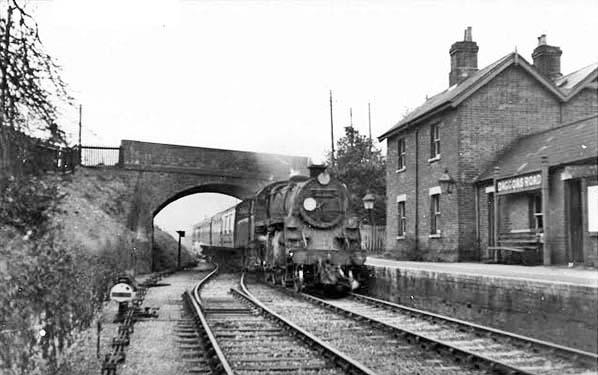 An unidentified BR Standard Class 4 2-6-0 arrived at Daggons Road with an Up, from the Bournemouth direction, service. The train is one of the Southern's three-car sets but its set number is illegible. These sets had a brake-end vehicle at each end, giving the approximate equivalent of two carriages of passenger accommodation within the set. The general air is of winter and steam from the carriage heating can be seen leaking from between the second and third carriages. At bottom left can be seen a Southern style shunt, or ground, signal. For the final sixty years of the line's existence shunt signals were the only form of signalling at Daggons Road.
Click here for Daggons Road Station Gallery 2:
 Home Page Home Page
|
 Notes: The station was opened as Alderholt and renamed Daggens Road later the same year. There was change of spelling to Daggons Road in 1904.The station name was something of a curiosity. Serving, and located on the western extremity of, the village of Alderholt the name is said to been chosen to avoid any confusion with Aldershot; something which could easily have happened at ticket offices due to accent variations or poor speech clarity. However, at the time the railway was built Alderholt was centred more to the north-east and grew towards the railway subsequently. At that time the nearest point of any note to the station was Charing Cross, today an area of Alderholt it was then little more than the name given to a road junction and would certainly not have been a suitable name for the station. Whether this was the reason for naming the station Daggons Road or if the Aldershot story is true is left for the reader to decide. The popular opinion is that "Daggons" was taken from the name of a local farm but the addition of "Road" calls this into question. Daggons is a location in itself, being a hamlet within the Civil Parish of Alderholt and this has been the case since 1894, prior to which it was within the Civil Parish of Cranborne. For this reason a highway named Daggons Road exists and is the most obvious source of the station's name, the station being located on the north side of the point where Station Road becomes Daggons Road. Station Road was called Alderholt Street until the coming of the railway.
Notes: The station was opened as Alderholt and renamed Daggens Road later the same year. There was change of spelling to Daggons Road in 1904.The station name was something of a curiosity. Serving, and located on the western extremity of, the village of Alderholt the name is said to been chosen to avoid any confusion with Aldershot; something which could easily have happened at ticket offices due to accent variations or poor speech clarity. However, at the time the railway was built Alderholt was centred more to the north-east and grew towards the railway subsequently. At that time the nearest point of any note to the station was Charing Cross, today an area of Alderholt it was then little more than the name given to a road junction and would certainly not have been a suitable name for the station. Whether this was the reason for naming the station Daggons Road or if the Aldershot story is true is left for the reader to decide. The popular opinion is that "Daggons" was taken from the name of a local farm but the addition of "Road" calls this into question. Daggons is a location in itself, being a hamlet within the Civil Parish of Alderholt and this has been the case since 1894, prior to which it was within the Civil Parish of Cranborne. For this reason a highway named Daggons Road exists and is the most obvious source of the station's name, the station being located on the north side of the point where Station Road becomes Daggons Road. Station Road was called Alderholt Street until the coming of the railway.
 The station consisted of a single platform 229 feet in length on the up side. Initially there was only one siding on the up side. This was a private siding running to the pottery and brick works belonging to Eustace & Colley. By 1901 a second short siding had been added running off the brickworks siding to a dock behind the platform. A 374' head shunt ran parallel to the main line to the north. The 1904 Railway Clearing House handbook of stations lists one private siding for Eustace & Colley but as the company was dissolved in 1901 the handbook was out of date. Kelly's Directory for 1915 lists a company at the station called Daggons Road Brickworks Ltd. The 1956 Railway Clearing House Handbook of Stations doesn't list any private sidings at Daggons Road and the 1959 OS map (reproduced below) shows the brickworks as a ruin and the siding lifted leaving only the short siding serving the dock.
The station consisted of a single platform 229 feet in length on the up side. Initially there was only one siding on the up side. This was a private siding running to the pottery and brick works belonging to Eustace & Colley. By 1901 a second short siding had been added running off the brickworks siding to a dock behind the platform. A 374' head shunt ran parallel to the main line to the north. The 1904 Railway Clearing House handbook of stations lists one private siding for Eustace & Colley but as the company was dissolved in 1901 the handbook was out of date. Kelly's Directory for 1915 lists a company at the station called Daggons Road Brickworks Ltd. The 1956 Railway Clearing House Handbook of Stations doesn't list any private sidings at Daggons Road and the 1959 OS map (reproduced below) shows the brickworks as a ruin and the siding lifted leaving only the short siding serving the dock. The station building, which included the station master's house, was a two storey double gabled brick building with a single storey brick extension with a hipped slate roof and no canopy at its north end. This housed the booking office and awiting room. Unusually the station's running in board was mounted on the roof of the booking office. It was later relocated to a pair of tall concrete stanchions in front of the booking office. A single storey timber building with a hipped slate roof stood further along the platform; this housed the ladies' waiting room. Between the two buildings there was a gents' toilet. Behind the two station builings there was another single storey building at an angle to the station. This isn't shown on the OS maps reproduced here but is clearly visible in some of the photos. It was probably a goods or parcels office.
The station building, which included the station master's house, was a two storey double gabled brick building with a single storey brick extension with a hipped slate roof and no canopy at its north end. This housed the booking office and awiting room. Unusually the station's running in board was mounted on the roof of the booking office. It was later relocated to a pair of tall concrete stanchions in front of the booking office. A single storey timber building with a hipped slate roof stood further along the platform; this housed the ladies' waiting room. Between the two buildings there was a gents' toilet. Behind the two station builings there was another single storey building at an angle to the station. This isn't shown on the OS maps reproduced here but is clearly visible in some of the photos. It was probably a goods or parcels office.
 On summer Saturdays in Southern days both lines served as useful alternatives for some of the many holiday trains run at peak periods. A few through trains from Waterloo ran to Swanage, while the Fordingbridge line offered similar facilities for holidaymakers from South Wales heading for the coast. Traffic on the line was always light and closure had been proposed before the line was eventually axed under Beeching from 4 May 1964, although goods traffic continued to use the line to Ringwood from Broadstone Junction until October 1966, after which it was cut back to West Moors for occasional military requirements.
On summer Saturdays in Southern days both lines served as useful alternatives for some of the many holiday trains run at peak periods. A few through trains from Waterloo ran to Swanage, while the Fordingbridge line offered similar facilities for holidaymakers from South Wales heading for the coast. Traffic on the line was always light and closure had been proposed before the line was eventually axed under Beeching from 4 May 1964, although goods traffic continued to use the line to Ringwood from Broadstone Junction until October 1966, after which it was cut back to West Moors for occasional military requirements. 